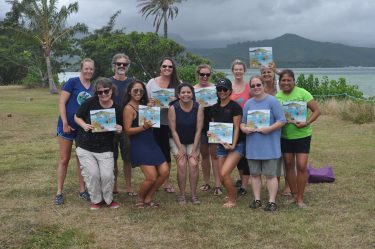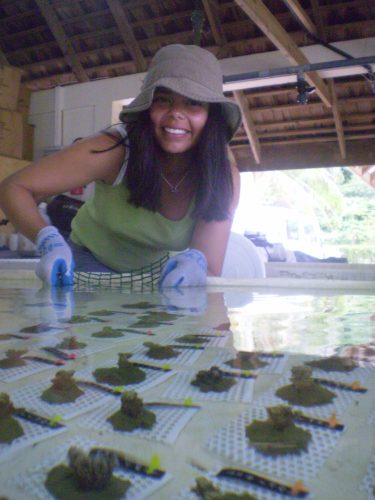
As a burgeoning marine biologist, Jackie Padilla-Gamiño found herself on the shores of Moorea, one of the best places in the world to study corals. The South Pacific island’s healthy reefs, shimmering clear waters, and pristine ecosystems set the stage for the newly minted Dr. Padilla-Gamiño to immerse herself in coral reef ecology.
She quickly realized others were interested in her research, too. While preparing over 100 coral fragments for an experiment along the shoreline, the local kids — who had been playing in the island’s salty lagoon nearby — became intrigued by Padilla-Gamiño’s work. They gathered closer to get a peek and ask questions.
“They were very curious and spoke French and Tahitian,” says Padilla-Gamiño. “In my broken French and English, I tried to tell them what I was doing.”
Padilla-Gamiño immediately saw herself in the kids. She grew up in Mexico and recalls seeing foreign scientists doing research in the field there. They appeared to be doing something interesting, she says, but would soon disappear back to their own home countries.
“You never knew what they were up to. And even if they published their data, as a kid that’s not something I had access to or would even understand.”
That experience drove Padilla-Gamiño, an assistant professor at the University of Washington’s School of Aquatic and Fishery Sciences, to think of ways to connect her research to those curious kids. Thoughts of a children’s book took hold, and the idea for “Kupe and the Corals” was born. Two years later the book was published.
“Kupe and the Corals” tells the story of a young boy who undertakes a journey of discovery, learning about the vast and diverse corals right in his backyard. While out on the reef one night with his father, he observes thousands tiny pink “bubbles” in the water. Curiosity leads him to a village elder and a scientist to talk about what he saw, where he learns how important corals are to the animals inhabiting the reef and to the people who live on the island.
“I wanted to leave something behind to share with these kids. That’s why for me, it was important to have it be translated into Tahitian,” says Padilla-Gamiño.

But Padilla-Gamiño wanted to reach even more kids. Beyond Tahitian, “Kupe and the Corals” has been translated into Paumotu, a Polynesian language spoken by people in the Tuamotu archipelago, as well as French, Spanish and English — five languages in all.
Initially, not all of Padilla-Gamiño’s colleageus were supportive of her efforts to write a children’s book, especially as a young scientist who was trying to establish her career. At first, this feedback made her second-guess her own priorities. But in the end, she chose to move forward and write the book.
“I remember thinking, ‘What? No, this is the time. We cannot wait to communicate.’ Maybe the kids I saw will have access to this book, and maybe we can generate change earlier. I don’t want to wait for the next generation, I want it to be this generation.”
“Kupe and the Corals” was published as part of the National Science Foundation’s Long Term Ecological Research program in their Schoolyard Series.

